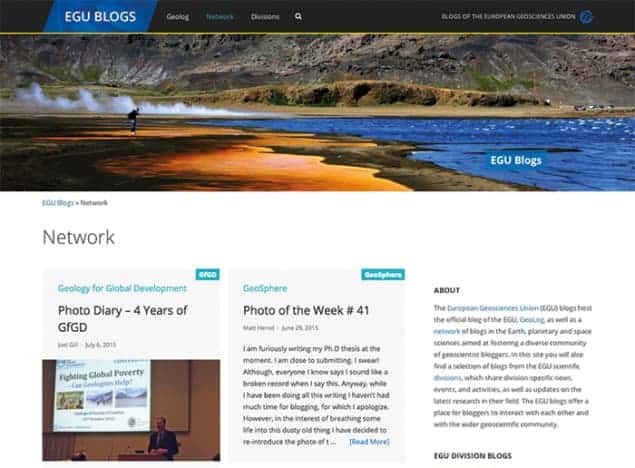
So what is the site about?
The European Geosciences Union (EGU) is the professional body for, erm, European geoscientists, so naturally its blog network is home to a bunch of blogs about geoscience. The network began in 2012 with just three blogs: GeoSphere (general geosciences), Green Tea and Velociraptors (palaeontology) and Geology for Global Development (social and policy issues relating to geology and natural risks). Since then, it has added five others, including several with close links to physics.
Who is behind it?
Most of the bloggers in the EGU network are early-career researchers or PhD students. The author of GeoSphere, for example, is Matt Herod, a PhD candidate in isotope geochemistry at the University of Ottawa, Canada. One of the newer blogs on the network, Polluting the Internet, is written by an atmospheric scientist, Will Morgan, who is now a postdoc at the University of Manchester. Two other EGU blogs, Geology Jenga (interdisciplinary topics) and Between a Rock and a Hard Place (planetary and earth sciences), have multiple authors, all of whom are (or were until recently) PhD students in the geosciences. The exception to the rule is An Atom’s-Eye View of the Planet, which focuses on how atomic-scale behaviour helps determine the Earth’s physical and chemical properties. Its author is Simon Redfern, a professor of mineral physics at the University of Cambridge.
How often are these blogs updated?
Individually, not that often, which is why we’ve grouped them together rather than writing about each of them separately. Collectively, though, the EGU authors usually produce one or two posts a week, and the main network page pulls in the most recent posts from all eight blogs. Hence, if there are lots of areas of geoscience that tickle your fancy (or if you don’t mind scrolling past the ones that don’t), the network page is the one to add to your bookmarks. And remember, quantity isn’t everything: the network’s least-active blog, Four Degrees, has been updated less than once a month since its 2013 founding, but each post is a long, richly illustrated and copiously cited essay on an important topic in environmental science, energy or policy.
Can you give me a sample quote?
From a December 2014 post on GeoSphere about “a very near miss by the Italian justice system” regarding a group of geochemists from the University of Siena who carried out an environmental study of two military firing ranges: “One of the goals…was to determine if DU [depleted uranium munitions] had been used. On the face of it the task seems simple enough: analyse soil, plants and water for uranium and its isotopic ratio and other potential contaminants from the munitions range (of which are there many). However, the complicating factor in all of this is the fact that adjacent to the firing range is an abandoned mine site called Baccu Locci. So the real question then becomes, which is it? Mine waste or DU or other military contaminants? Their findings were that there was no contamination from DU in the region. These results met with extreme opposition from the local prosecutor who acted on the advice of a nuclear physicist from the University of Brescia who felt that geochemistry was not the proper way to investigate this problem and that the University of Siena scientists were hiding something. The geochemists were charged with two crimes in connection with their results.”
- Enjoy the rest of the August 2015 issue of Physics World in our digital magazine or via the Physics World app for any iOS or Android smartphone or tablet. Membership of the Institute of Physics required



